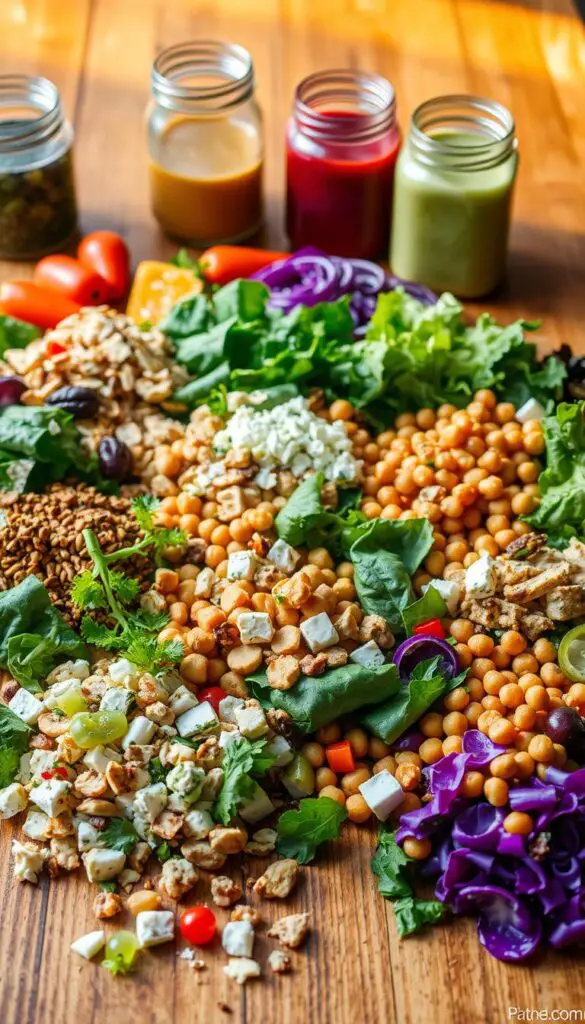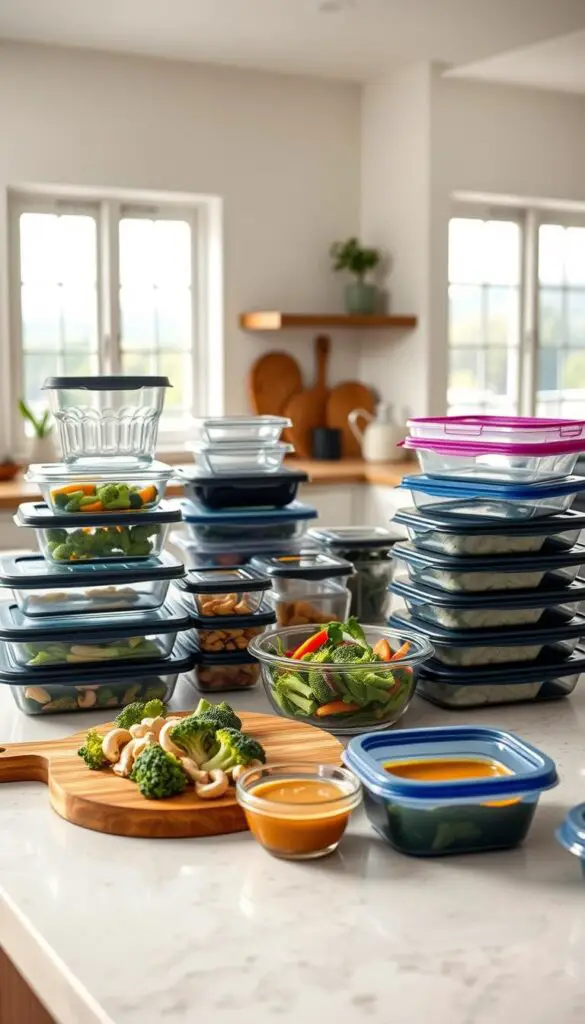I'll never forget the day I combined leftover roasted veggies with pantry staples – the result was this colorful masterpiece that's become my go-to meal. What started as kitchen experimentation evolved into a balanced dish celebrating crisp textures and bold flavors, perfect for busy weeknights or potluck gatherings.
This creation stands out because it delivers restaurant-quality taste through simple techniques. The magic lies in contrasting elements: tender-crisp florets meet protein-packed legumes, while a zingy sauce ties everything together. Best of all, it's naturally vegan and gluten-free, making it ideal for diverse dietary needs.
Every ingredient plays a specific role – from the earthy base notes to the bright citrus accents in the dressing. That creamy topping you see? It's a clever blend of nut butter and tangy vinegar that adds richness without dairy. I've perfected the ratios through multiple test batches to ensure maximum flavor with minimal effort.
Ready to make this crowd-pleaser? Let's explore the fresh components and smart prep methods that make this dish special. You'll discover how to build layers of taste while keeping things nutritious and satisfying.
Key Takeaways
- Features a perfect balance of crunchy and creamy textures
- Completely plant-based and suitable for various diets
- Packs protein and fiber for lasting energy
- Uses simple techniques for complex flavors
- Customizable with seasonal ingredients
- Includes a versatile dressing that doubles as marinade
My Salad Story
It all began on a hectic Thursday evening when my fridge held random veggies and a lonely can of legumes. Instead of ordering takeout, I challenged myself to create something satisfying yet effortless. That’s when I discovered how roasted florets and protein-rich beans could transform into a vibrant meal.
My Inspiration Behind the Recipe
I wanted to capture the essence of street food flavors without spending hours prepping. The idea struck me while flipping through old travel photos—memories of bustling markets filled with aromatic sauces. That’s how the zesty dressing was born: a bold mix of freshly grated root and creamy nut butter that elevates every bite.
A Quick Overview of the Dish
This dish shines because it’s fast without sacrificing nutrition. You’ll spend more time waiting for the oven than chopping ingredients. I love how the textures play together—crispy edges from roasting contrast beautifully with tender greens. It’s become my weekday hero, ready in under 30 minutes yet fancy enough for guests.
What makes it special? The dressing doubles as a marinade, infusing layers of flavor while you multitask. I’ve shared this recipe with friends who juggle busy schedules, and they all rave about its adaptability. Swap veggies based on what’s seasonal, or add extra crunch with toasted seeds—it’s endlessly customizable.
Nutritional Benefits and Flavor Profile
What makes this dish a kitchen staple? It’s the smart fusion of nutrient-dense ingredients that work overtime for your health. Let’s unpack why every forkful feels like a wellness boost.
Wholesome Ingredients for Energy and Vitality
Quinoa steals the spotlight here, packing 8g of plant-based protein and 5g of fiber per cooked cup. Combined with chickpeas, you get a complete amino acid profile that keeps energy levels steady. Broccoli adds crunch plus vitamin C – one cup delivers 135% of your daily needs!
I love how shredded carrots and leafy greens team up for digestive support. The fiber content (about 12g per serving) helps maintain gut health while keeping you full. As one nutritionist friend told me:
“Meals like this prove that eating well doesn’t mean sacrificing flavor or satisfaction.”
The Flavor Balance of Sweet, Spicy, and Tangy
The dressing’s magic comes from its three-note harmony. Maple syrup’s natural sweetness dances with chili flakes’ heat, while lime juice adds bright acidity. This trio enhances the earthy base flavors without overpowering them.
Crushed nuts lend satisfying texture, and a dash of tamari brings umami depth. It’s that perfect balance – enough zing to wake up your taste buds, but gentle enough for sensitive palates. Your body gets nourished, and your mouth gets a party!
Essential Ingredients for a Winning Salad
The secret to this vibrant dish lies in selecting components that play well together. Each element brings unique qualities to your bowl, creating harmony between crunch and creaminess.
Fresh Produce and Crunchy Veggies
Broccoli slaw forms the crisp foundation. I love how its ruffled edges catch every drop of dressing. Combined with shredded carrots, you get a confetti-like base that’s visually stunning and packed with fiber.
Protein-rich chickpeas add heartiness while quinoa offers nutty undertones. For the dressing, natural peanut butter acts as the flavor conductor – its quality matters! Look for varieties with just peanuts and salt for optimal creaminess.
The sauce gets its magic from three key players:
- Rice vinegar cuts through richness with bright acidity
- Maple syrup balances spice with subtle sweetness
- Soy sauce (or tamari) adds savory depth
Need substitutions? Try sunflower seed butter for nut-free versions. Swap quinoa with couscous if you prefer softer grains. The beauty lies in customization – just keep veggies fresh and crunchy for maximum texture contrast.
Now that we’ve covered the building blocks, let’s explore how these ingredients transform into something extraordinary through simple preparation steps.
Step-by-Step: Thai Cashew Chickpea Broccoli Salad with Ginger Peanut Dressing
The real magic happens when fresh components unite. My go-to trio? Crisp florets, protein-packed legumes, and a sauce that makes taste buds dance. Let’s meet the rockstars that make this thai chickpea salad unforgettable.
Power Players on Your Cutting Board
Broccoli’s ruffled edges catch every drop of dressing like nature’s spoons. Roasted until just tender, it keeps that satisfying crunch. Chickpeas bring earthy notes and a meaty bite – I always pat them dry for better crispiness.
That creamy peanut sauce? It’s simpler than you think. My secret? Freshly grated ginger and a squeeze of lime. One friend confessed:
“I’d drink this with a straw if it were socially acceptable!”
Quick tips from my kitchen:
- Use pre-cooked grains to save 15 minutes
- Tear basil by hand for more aromatic oils
- Toast nuts in a dry pan for depth
Quality matters here. Splurge on fresh citrus – bottled juice can’t match its zing. For the chopped thai chickpea element, I prefer smaller pieces that cling to other ingredients. This recipe thrives on contrasts: soft and crunchy, sweet and tangy, warm and cool.
Ready to combine these heroes? Let’s move to the mixing bowl where everything comes together beautifully.
Detailed Step-by-Step Instructions
The moment everything comes together is my favorite part – watching vibrant colors merge into one harmonious bowl. Let’s transform those prepped ingredients into something extraordinary through smart mixing techniques.
Mixing and Tossing the Ingredients
Grab your largest mixing vessel – I use a wide salad spinner for easy tossing. Combine roasted florets, cooked grains, and rinsed legumes first. Add shredded veggies last to preserve their crunch. Use tongs to gently fold everything like you’re mixing pancake batter – overworking makes things soggy.
Pro tip: Let ingredients sit at room temperature for 10 minutes before combining. This prevents wilting and helps flavors mingle naturally. A friend once texted me mid-toss:
“This feels like edible confetti – too pretty to eat!”
Crafting the Zesty Peanut Dressing
Whisk ¼ cup natural nut butter with 2 tablespoons each soy sauce and rice vinegar. Add 1 tablespoon maple syrup (or honey) and 1 teaspoon freshly grated ginger. Thin with warm water until it ribbons off your whisk – about 3 tablespoons does the trick.
Pour over your colorful base and toss with clean hands for 30 seconds. The heat from your palms slightly softens the sauce, helping it cling better. Finish with a squeeze of lime – its acidity wakes up all the flavors. Serve immediately or chill for up to 4 hours to let the tastes deepen.
Customizing Your Salad: Variations and Substitutions
One of my favorite things about this recipe is how easily it adapts to different tastes and needs. Whether you’re avoiding nuts or craving extra crunch, a few smart swaps can transform your bowl without losing its vibrant personality.

Vegan and Nut-Free Alternatives
For friends with allergies, sunflower seed butter works beautifully instead of peanut butter. Its earthy flavor pairs well with a squeeze of lime and a pinch of chili flakes. Tahini lovers can use sesame paste – just thin it with extra water and boost the soy sauce by half a teaspoon for depth.
Need plant-based protein? Crumble baked tofu into the mix. I press mine between paper towels for 10 minutes to improve texture, then toss it in the dressing before assembling. A reader once shared:
“The tofu trick made this salad my new meal-prep hero!”
Adding Extra Protein and Texture
Rotisserie chicken adds hearty appeal – shred half a cup into the bowl for quick prep. For seafood lovers, grilled shrimp brings a lovely charred note. Vegetarians can double the chickpeas or stir in cooked quinoa.
Swap veggies seasonally: massaged kale holds up better than leafy greens if you’re making it ahead. Roasted butternut squash cubes add caramelized sweetness that balances tangy dressings perfectly. Just remember to adjust salt levels when adding salty ingredients like olives or capers.
Serving Suggestions and Pairing Ideas
Transform every meal into a vibrant experience with these versatile serving strategies. Whether you’re plating for a solo lunch or hosting friends, this dish adapts beautifully to any occasion. Let me share my favorite ways to make it shine at the table.
Perfect as a Lunch, Dinner, or Side Dish
For quick lunches, pack individual servings in mason jars—layer dressing at the bottom to keep greens crisp. At dinner, pair it with roasted squash or grilled tofu for a heartier meal. As a side, it complements grilled meats beautifully without overpowering main flavors.
Presentation matters! Serve in a wide, shallow bowl to showcase colorful ingredients. Top with toasted pepitas or a drizzle of maple-infused dressing for visual appeal. One friend raved:
“It’s like edible confetti – I always snap photos before digging in!”
Pairing with Soups, Sandwiches, and More
Balance rich flavors by pairing with light miso soup or zesty gazpacho. For sandwich nights, try it alongside avocado toast or spiced veggie burgers. The tangy notes cut through creamy textures perfectly.
| Meal Occasion | Perfect Pair | Garnish Tip |
|---|---|---|
| Weekday Lunch | Quinoa-stuffed pita | Sprinkle chili flakes |
| Dinner Party | Coconut curry soup | Add edible flowers |
| Picnic Side | Grilled chicken skewers | Toss with fresh herbs |
Let leftovers mingle! Flavors deepen beautifully over 2-3 days in airtight containers. If stored, revive it with a squeeze of citrus juice and a dash of warm water to loosen the dressing. Serve chilled or at room temperature – both work wonders.
Tips for Meal Prep and Storing Your Salad
Meal prep transformed my chaotic weeknights into smooth-sailing dinners. With smart storage tricks, this vibrant dish stays crisp and flavorful for days – no sad, soggy leftovers here. Let me share my tried-and-true methods for keeping your bowl ready in minutes.

Make-Ahead and Storage Guidelines
I prep components separately on Sundays. Roasted veggies chill in glass containers, while grains and legumes get their own bowl. The dressing stays fresh in small cups with tight lids – this separation prevents sogginess.
For grab-and-go lunches, layer ingredients in mason jars:
- Dressing at the bottom
- Grains next
- Crunchy veggies on top
One reader shared:
“This system cut my lunch prep time from 15 minutes to 30 seconds!”
Keeping Your Salad Fresh for Days
Store everything in airtight containers for 3-5 days of freshness. If greens wilt, revive them with ice water for 5 minutes. Add fresh herbs or toasted nuts before serving to boost texture.
Found your mix looking dry? A splash of citrus juice and warm water refreshes the dressing perfectly. For variety, toss in seasonal fruits or swap grains – leftover quinoa becomes a whole new meal with different spices.
Conclusion
This vibrant bowl proves that nourishing meals don’t require complicated steps. Through smart combinations of texture-rich veggies and bold sauces, you get a meal that fuels your day while delighting your taste buds. What started as a fridge clean-out experiment became my most-requested recipe for its versatility and crowd-pleasing flavors.
I encourage you to make it your own—swap nut butter for seed varieties, or add seasonal produce. The base formula works wonders with whatever you have on hand. Need it faster? Use pre-chopped veggies or bottled citrus juice without sacrificing quality.
If you try this creation, I’d love to hear how it turned out! Drop a comment below with your twist, or tag me on Instagram using #FreshBowls. Your votes and feedback help shape future recipes shared in this space.
Thanks for joining me in celebrating simple, wholesome cooking. For more quick meal ideas, explore other posts on the blog. Keep this recipe bookmarked—it’s a lifesaver for busy weeks and last-minute gatherings alike. Happy mixing!
FAQ
Can I make this salad nut-free?
Absolutely! Swap peanut butter for sunflower seed butter and skip cashews. Try roasted pumpkin seeds for crunch. The dressing still tastes rich without peanuts.
How long does the ginger peanut dressing stay fresh?
Store it in an airtight container for up to 5 days. If it thickens, whisk in a splash of lime juice or water to revive the creamy texture.
Can I prep this salad ahead for lunches?
Yes! Keep the dressing separate until ready to eat. The veggies and chickpeas hold up well for 3-4 days. I often double the batch for easy weekday meals.
What’s a good protein addition to make it heartier?
Grilled tofu, shredded chicken, or edamame work great. I’ve added baked tempeh for a plant-based boost—it soaks up the tangy sauce beautifully.
Is maple syrup necessary for the dressing?
Not at all! Honey or agave nectar also work. For a sugar-free version, blend in a pitted date or skip sweeteners entirely—it’ll still have a zesty kick.
Can I use frozen broccoli instead of fresh?
Sure! Thaw and pat it dry first. Roasting frozen florets with a pinch of salt adds depth. Fresh gives a crisper bite, but both options taste delicious.
What if I don’t have rice vinegar?
Apple cider vinegar or lime juice are solid substitutes. Adjust to taste—start with less, as acidity levels vary. The goal is that bright, tangy finish!


